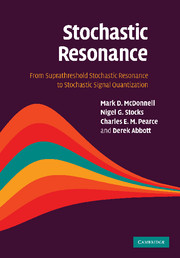Book contents
- Frontmatter
- Contents
- List of figures
- List of tables
- Preface
- Foreword
- Acknowledgments
- 1 Introduction and motivation
- 2 Stochastic resonance: its definition, history, and debates
- 3 Stochastic quantization
- 4 Suprathreshold stochastic resonance: encoding
- 5 Suprathreshold stochastic resonance: large N encoding
- 6 Suprathreshold stochastic resonance: decoding
- 7 Suprathreshold stochastic resonance: large N decoding
- 8 Optimal stochastic quantization
- 9 SSR, neural coding, and performance tradeoffs
- 10 Stochastic resonance in the auditory system
- 11 The future of stochastic resonance and suprathreshold stochastic resonance
- Appendix 1 Suprathreshold stochastic resonance
- Appendix 2 Large N suprathreshold stochastic resonance
- Appendix 3 Suprathreshold stochastic resonance decoding
- References
- List of abbreviations
- Index
- Biographies
4 - Suprathreshold stochastic resonance: encoding
Published online by Cambridge University Press: 23 October 2009
- Frontmatter
- Contents
- List of figures
- List of tables
- Preface
- Foreword
- Acknowledgments
- 1 Introduction and motivation
- 2 Stochastic resonance: its definition, history, and debates
- 3 Stochastic quantization
- 4 Suprathreshold stochastic resonance: encoding
- 5 Suprathreshold stochastic resonance: large N encoding
- 6 Suprathreshold stochastic resonance: decoding
- 7 Suprathreshold stochastic resonance: large N decoding
- 8 Optimal stochastic quantization
- 9 SSR, neural coding, and performance tradeoffs
- 10 Stochastic resonance in the auditory system
- 11 The future of stochastic resonance and suprathreshold stochastic resonance
- Appendix 1 Suprathreshold stochastic resonance
- Appendix 2 Large N suprathreshold stochastic resonance
- Appendix 3 Suprathreshold stochastic resonance decoding
- References
- List of abbreviations
- Index
- Biographies
Summary
In many of the systems and models in which stochastic resonance has been observed, the essential nonlinearity is effectively a single threshold. Usually SR occurs when an entirely subthreshold signal is subjected to additive noise, which allows threshold crossings to occur that otherwise would not have. In such systems, it is generally thought that when the input signal is suprathreshold, then the addition of noise will not have any beneficial effect on the system output.
However, the 1999 discovery of a novel form of SR in simple threshold-based systems showed that this is not the case. This phenomenon is known as suprathreshold stochastic resonance, and occurs in arrays of identical threshold devices subject to independent additive noise. In such arrays, SR can occur regardless of whether the signal is entirely subthreshold or not, hence the name suprathreshold SR. The SSR effect is quite general, and is not restricted to any particular type of signal or noise distribution.
This chapter reviews the early theoretical work on SSR. Recent theoretical extensions are also presented, as well as numerical analysis of previously unstudied input and noise signals, a new technique for calculating the mutual information by integration, and an investigation of a number of channel capacity questions for SSR. Finally, this chapter shows how SSR can be interpreted as a stochastic quantization scheme.
Introduction
Suprathreshold stochastic resonance (SSR) is a form of stochastic resonance (SR) that occurs in arrays of identical threshold devices. A schematic model of the system is shown in Fig. 4.1, and is described in detail in Section 4.3.
- Type
- Chapter
- Information
- Stochastic ResonanceFrom Suprathreshold Stochastic Resonance to Stochastic Signal Quantization, pp. 59 - 119Publisher: Cambridge University PressPrint publication year: 2008



